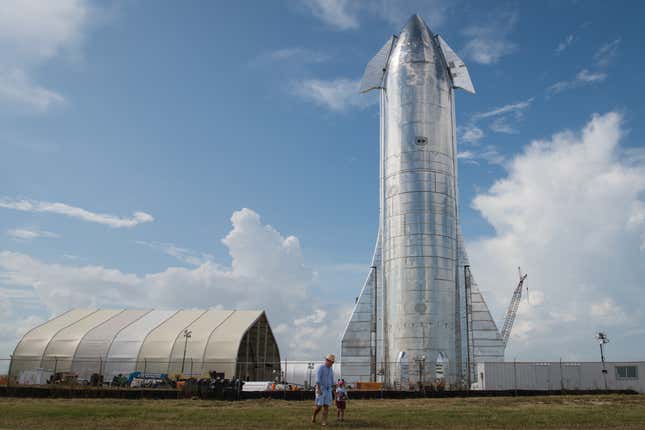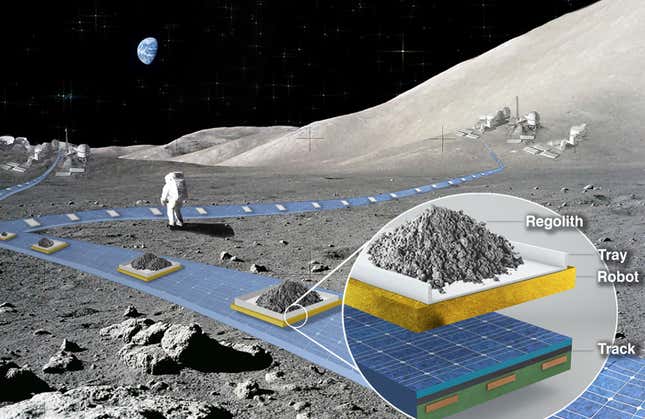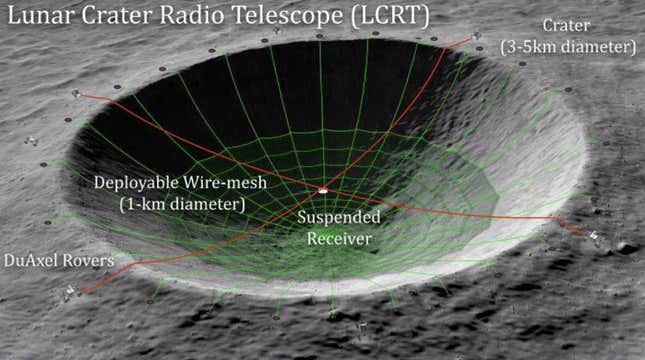
Enhanced Space Access Means New Remarkable Science Ahead
Rocket launches are expensive and laborious, but for decades they’ve been the price of doing business for space agencies hoping to get their latest satellite, telescope, or team of astronauts into the great blue yonder.
But new missions and mission concepts are preparing for a brave new world, one in which humankind has an established, semi-permanent presence off-Earth. It begins with the Moon, where humans haven’t been for 51 years. But once we learn how to have a sustainable, long-term presence there, the great expanse beyond seems far more attainable.
Human transit to and habitation of other worlds and satellites is part of the equation. Another part of the equation is building experiments and infrastructure that harnesses the surrounding environment, a process called in-situ resource utilization, or ISRU.
How we will get to and make use of the cosmos are fundamental questions in our pursuit of better understanding it. As we step out from our blue marble and test the waters (or regolith) beyond, scientists will develop new ways of understanding the universe. Gizmodo took some time to speak with technologists, engineers, and theorists who work on technologies that will make our scientific investigation of space easier.
Why do we need to do science in space?
There are observatories on Earth that look at the cosmos and its quirky phenomena, from telescopes that observe ancient light to super-sensitive detectors that feel reverberations of gravitational ripples in spacetime. So why do science in space?
For one, it’s hard to see space from Earth. Skyglow from light pollution is making it increasingly difficult to see the stars, according to research published earlier this year. But skyglow aside, our planet was not optimizing for astronomical observations as it took shape over the last 4.6 billion years.
“There’s a huge fraction of the electromagnetic spectrum that you’re blind to from the surface of the Earth,” said Paul Goldsmith, an astronomer at NASA’s Jet Propulsion Laboratory, in a video call with Gizmodo. “The very atmosphere—especially the water and oxygen in our atmosphere that let us live here—are what makes life challenging for astronomers.”
Accordingly, space agencies launch observatories that are suspended in orbit. That began with OAO-2, the first successful space telescope and the ancestor of all modern space telescopes. But now, the Webb Space Telescope takes in far- and near-infrared light one million miles from Earth and the Chandra X-ray Observatory orbits Earth tens of thousands of miles from the planet to avoid the worst of its radiation.
But there is only so much science we can do with observations from afar, even those done by the most keen-eyed astronomical instruments. Consider the Moon: studying the lunar regolith and mapping its craters through a telescope offer clues on its formation and makeup, but analyzing lunar samples (namely those collected during the Apollo missions and, more recently, China’s Chang’e-5 lander) give scientists priceless insights into the makeup of lunar gasses and how the Moon might hold water. And on Mars, the Perseverance rover is actively collecting rock samples to eventually ship to Earth as part of the Mars Sample Return mission. Those samples will be probed for hints as to Mars’ geological history, but also evidence that the Red Planet may have once supported ancient microbial life.
The search for life—even signs of ancient life—beyond Earth is a quest of paramount importance. If we were to find signs that life does, or did, exist beyond our own world, it would allow us to ask serious questions about the ethics of exploring space and the implications of us not being alone in the universe in a material way (we’ve been asking these questions hypothetically for a long time now). If signs of life were found beyond Earth, it would also change the types of missions that space agencies and commercial entities would prioritize.
Of course, it would be easier—and in the long run, arguably more cost-effective—to have an established, sustainable human presence exploring Mars on its surface than to regularly launch vehicles to the planet to retrieve samples like those being collected by Perseverance.
The planned Artemis missions may showcase that idea on the Moon. Despite their name, the Artemis missions are not really the twin of the Apollo missions. Apollo’s purpose was to visit and take samples of the Moon, and then get all the astronauts back to Earth in one piece. Artemis will set the foundations for a sustained human presence on the Moon, from infrastructure on the lunar surface to the Lunar Gateway, a space station that will support astronauts in orbit of our rocky satellite as the International Space Station does Earth.
Easier access to the final frontier
Crucially, the costs of rocket launches—the largest barrier to getting new missions into space, by Goldsmith’s measure—are falling. 2023 is seeing a huge number of rocket launches and reusable rockets will make even more launches possible for less cost. SpaceX’s reusable Falcon 9, for example, is responsible for nearly half of all orbital launches this year to date, according to Gunter’s Space Page.
“You have to hope that the vehicle to get it there isn’t hugely expensive or else the whole thing becomes unaffordable,” Goldsmith said. “So the hope is that the commercial space costs dropping will get you into space and/or to the surface of the Moon in a way that you can put more of the money into the payload and do exciting science rather than mostly paying to simply get there.”
And as rocket costs fall, their power and carrying capacities are on the rise. Consider Starship, SpaceX’s in-development megarocket, which is expected to usurp the company’s Falcon 9 as SpaceX’s marquee launch vehicle.

NASA’s Space Launch System (SLS) generates 8.8 million pounds of thrust at launch; the 400-foot-tall Starship, by contrast, will exert 16.5 million pounds of thrust. And as previously reported by Gizmodo in our exhaustive (no pun intended) guide on the new rocket, Starship will be able to cary 330,000 pounds (150 metric tons) of payload to low Earth orbit inside its oversized payload fairing.
Simply put: Starship is poised to deliver heavier and bigger equipment to space, meaning scientists and engineers will be able to include more bells and whistles to their future mission concepts. Needless to say, the bounds of a mission concept will always be constrained by what can actually be launched into space. That said, in-space manufacturing—a capability currently on the horizon—will enable the development of profoundly more complex space-based tools.
At the same time, new technologies are improving our ability to observe the cosmos. The Webb Space Telescope, a $10 billion space observatory launched in December 2021, has already produced a year’s worth of scientific imagery, as well as copious amounts of data on distant molecular clouds and the prevalence of habitable worlds, among many other lines of inquiry.
The Webb Space Telescope had a total payload mass of 13,670 pounds. While a mission’s mass is by no means an indicator of its impact, fewer limits on mission payloads (courtesy of Starship) will mean more opportunities to strap up a rocket with scientific equipment.
Webb is positioned at L2, a region in space about one million miles from Earth that allows the telescope to image the universe with minimal fuel burn. At such a distance, L2 is also spared light pollution from Earth and the glut of satellite constellations putting streaks of light in other observatories’ images.
Ironically, the same company that is developing the rocket of spaceflight’s future is responsible for clogging up low-Earth orbit. According to statistics kept by Harvard-Smithsonian astrophysicist Jonathan McDowell, SpaceX has launched 5,048 Starlink internet satellites to date, of which 4,670 are currently operational.
It’s hard to say precisely what the future applications of megaconstellations will be, but astronomers are increasingly worried about how the devices will mess with telescopic observations. Scientists have developed software that can edit streaks of light from satellites out of their imagery, but that seems more like a stopgap measure than a panacea.
On Earth, devices like the largest digital camera ever built will help scientists see the sky better than ever, in spite of the atmosphere. The upcoming 3.2-gigapixel camera will be the cornerstone of the Vera Rubin Observatory’s Legacy Survey of Space and Time, a 10-year survey that will image the night sky every 15 seconds, taking a complete portrait of the southern sky about once a week. High in Chile’s Atacama Desert, the camera will deal with little light pollution and fewer atmospheric perturbations than other Earth-based telescopes.
With new technologies innovating the way we see the cosmos and falling prices on rocket launches, scientific missions can be launched more frequently, hastening the rate of discovery.
What is the future of science in space?
A key question surrounding science missions beyond Earth is who, or what, will build them. Space is inhospitable to humans, with intense temperature changes, radiation, no breathable air to speak of, and no immediately available sources of food or water. The answer, therefore, is robots. We’ve developed robots that fly on Mars and that drill into the planet’s rocky history, so why not send more robots into space to do the work that humans can’t, or perhaps should not?
Angelo Vermeulen, a biologist and space systems researcher at Delft University of Technology in the Netherlands, said that people in the space—erm, space—sometimes see the two types of explorer as mutually exclusive, and it’s a “somewhat charged” topic in the space community.
“I think it’s a little unfortunate that sometimes it ends up in a discussion like this because it’s probably both,” Vermeulen told Gizmodo in a video call. “As you can imagine, having humans out there with robotic companions seems like the best of both worlds.”
Vermeulen is a co-author on a paper recently published in Frontiers in Astronomy and Space Science exploring bioregenerative life support systems—that is, systems that can adjust and adapt themselves over the course of a journey through space.
“We don’t need to discover some new laws of physics to kickstart interstellar exploration,” Vermeulen said. “Between 40 and 100 years, you should be able to reach (the nearest stars). And so we enter the domain of multigenerational space travel, which has its own sets of challenges—including ethical, of course, I’m not shying away from that.”
The same types of systems designed for Vermeulen’s Evolving Asteroid Starships project could be applied to a much nearer target than the nearest stars: the Moon. NASA plans to get humans back on the Moon within this decade, so designing systems that make a sustained human presence possible on our cold, atmosphere-less satellite are of utmost importance. And no entity is doing more to tackle those questions than the NASA Innovative Advanced Concepts (NIAC) program, the testing ground for scientific experiments off-Earth.
NIAC produces a steady stream of funded projects to improve humankind’s ability to travel beyond Earth and investigate the cosmos. From learning how to transform Martian soil into arable land to using lasers to propel spacecraft, NIAC proposals work to solve problems that have not yet become problems, so that humankind is ready for when they arise.

One such design is the Flexible Levitation On A Track (FLOAT) proposal, which is a magnetic levitation system that could help move lunar regolith (or other heavy things on the Moon). The system is designed to operate like a floating conveyor belt, shipping mined materials on the lunar surface without having to worry about the uneven lunar surface. Ethan Schaler, FLOAT’s principal investigator (and also the principal investigator of the SWIM NIAC concept, and a robotic systems engineer for NASA’s Perseverance mission on Mars), said that designing a mission is (kind of) fun and games when you’re working on a concept. “The devil is always in the details when you start building the flight hardware,” Schaler told Gizmodo in a video call.
Related article: Will Mining the Moon and Asteroids Be Worth the Trouble?
“I am an optimist on research; I love thinking about cool new ideas and how they might work,” Schaler added, “and I’m a realist when it comes to actual missions. And when you’re working a mission, you have to think about every way it can go wrong and design ways to avoid all of them.”
A levitating track for carrying heavy material off-Earth is just one NIAC mission concept designed with the Moon in mind. Some sound even more sci-fi: consider the Lunar Crater Radio Telescope (LCRT), a NIAC mission concept which aims to turn a crater on the far side of the Moon into a detector for ultra-long-wavelength radio waves emanating from the universe’s Dark Ages.
“The reason why the Dark Ages are a good time to look at dark matter and matter’s interaction is because there is nothing else (happening). The moment the first stars are born…you lose all the signatures of dark energy,” said Saptarshi Bandyopadhyay, a robotics technologist at NASA’s Jet Propulsion Laboratory and a member of the LCRT team, in a video call with Gizmodo.

Being located on the far side of the Moon would mean that the telescope’s data would need to get beamed up to an orbiter that would then transmit the data to Earth.
“LCRT has a double problem,” said Goldsmith, who is also a member of the LCRT project. “One is when you go to very, very, very low frequencies, the Earth’s ionosphere starts blocking the signals. And then you also have the problem that the interference from all the transmissions from everything on Earth would easily swamp the signal you’re looking for.”
So, the robot-installed lunar telescope must be on the Moon’s far side, and because it’s just looking for a specific range of low-frequency waves, it may be hard for supporters to justify its cost (in the ballpark of a couple to a few billion dollars) in comparison to its utility to the larger astronomical community.
“No one else in the astronomy department cares about it, other than the few people who care about early universe science,” Bandyopadhyay added. “So this sort of journey ahead for us is quite hard.”
Bandyopadhyay separated the types of science missions done off Earth into three classes: missions that are uniquely feasible from space, missions that use space-based instruments in tandem with Earth-based instruments, and science missions designed to keep human beings alive in space. All three are in humankind’s plans, but the former two will be made easier if the third is prioritized. Having humans on site on the Moon, Mars, and perhaps elsewhere thereafter will mean they can problem solve faster than it takes Earth-based scientists to diagnose and solve problems remotely.
To infinity and beyond?
With any luck—and plenty of planning—humans will return to the Moon within the decade. Space agencies and commercial partners are developing the technologies necessary to both get our species to Mars and allow for a sustainable, long-term presence on the planet. We’re a long, long way off from interstellar travel, but it’s not beyond the realm of possibility.
“I think I and many other people look at the Earth more like a cradle,” Vermeulen said. “It’s a starting point. And there is this beauty in reaching out and connecting with where we came from—this massive universe—and go deeper into that.”
The technologies of tomorrow are being designed today, so that humans will be ready when the technology to travel beyond Earth and stay there exists. And even once it does exist, we’ll need to innovate on those technologies, make the manufacturing of these tools cheaper, and make their designs more intuitive and useful, and so on.
Right now, transporting humans to Mars is unfeasible; it’s a long journey with a short, intermittent launch window, and any ship carrying humans would need to be properly shielded from radiation.
“Once we figure that out, I think humans will truly be a planet-faring civilization,” Bandyopadhyay said. “I would anticipate that a hundred years from now, we would have bases on Moon and Mars. And to make all of that happen, you need to first figure out how to make that happen.”
Sometimes it feels like the march of spaceflight is slow, but even for all the careful work of people designing and launching missions, it actually is moving at a clip. You just need to step back to see how much more is being done today than even 10 years ago to realize that we’re on the cusp of a very new kind of space exploration, and all the new discoveries that will come with it.
More: The Year Ahead in Spaceflight
